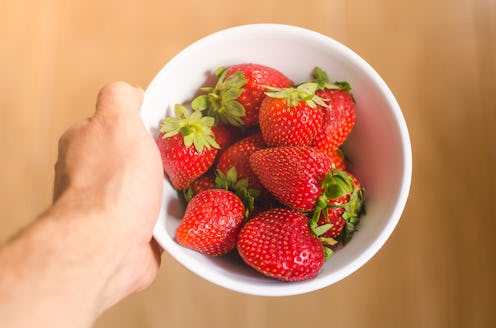Life
10 Tips For Eating Healthy When You're Broke

When you're low on money, your first instinct probably isn't to buy a stalk of kale over an inexpensive cheeseburger, but if you're trying to eat healthy, it can be hard to find options that don't break the bank. Luckily, there are a number of ways to eat healthy even if you're broke, and it's a common misconception that healthy eating is only for people with money. Although buying a premium green juice or a fancy gluten-free superfood bread might cost you a pretty penny, there are plenty of other ways to eat healthy than spending your whole paycheck at a fancy store.
"The misperception that you have to spend a lot to eat healthfully is simply inaccurate," says Rima Kleiner, MS, RD of “Dish on Fish” over email. "Yet, this myth continues to be perpetuated and, worst of all, it is discouraging to consumers who assume they can’t afford to feed their families well so they resort to less healthy options."
A survey conducted by food industry research firm Technomic found that 53 percent of people say they buy unhealthy foods because of cost constraints. But with the right planning and preparing — and a few trips to the grocery store — you can eat a healthy diet even if you're trying to save money.
If you're watching your spending but still want to eat healthy, consider these 10 tips from dietitians on how to eat healthy even if you're broke.
1. Buy In Bulk
Foods in bulk are often offered at a discounted price. "While it may cost more upfront when buying certain items, you can easily buy many in bulk that last a long time in the pantry and/or can be frozen, prepped for later use, or proportioned after buying and then stored," says Keri Glassman, MS RD CDN over email.
2. Only Buy Organic When Necessary
Choosing to buy organic is a great way to avoid pesticides and GMOs, but not all foods are worth the organic price tag. "If you can’t buy everything organic, focus on buying organic foods which are most likely to contain high amounts of pesticides," says Glassman. "Check out the dirty dozen and clean fifteen to be informed and make the best choices."
3. Meal Prep
There's a reason why meal prep is big in the fitness community right now — it's cheap and ensures you eat most of your meals at home. "Eating healthy can be less expensive when you plan ahead," says Glassman. "By meal prepping and packing meals you’ll save money and use up your fresh produce before it has a chance to go bad. For example, making chicken and broccoli rabe for dinner? Use the leftover 3 ounces of chicken and broccoli rabe and mix with canned chickpeas and frozen mixed veggies to make a complete lunch."
4. Buy Frozen
Frozen fruits and vegetables can be significantly cheaper than fresh produce — and they surprisingly can contain more nutrients. "Foods are frozen at their peak ripeness, so they actually can be healthier than their fresh counterparts," says Glassman.
5. Shop In Season
"The real, whole foods that are in season will be most abundant, and therefore cheaper in the checkout line," says Glassman. Use a seasonal produce guide to see what fruits and vegetables are being grown right now, and better yet, find out what is produced locally.
6. Participate In Meatless Monday
"Eating meatless meals can save money on the grocery bill, plus they can help your health too," says Molly Morgan, RD, CDN, CSSD over email. "Try egg-based dishes, grain-and-veggie-based dishes, vegetable stir fry, etc." If you need more ideas, you can check out MeatlessMonday.org for recipe ideas.
7. Buy Foods Whole, Not Pre-Chopped
It's tempting to buy the pre-chopped vegetables or fruit out of convenience, but this extra service comes at a price. "Buying whole carrots and then peeling and slicing or chopping them is more cost effective than buying baby carrots, which are often $0.80 - $1 more per pound compared to 'regular' carrots," says Morgan.
8. Use In-Store Coupons
There's no need to do any extreme couponing, but pay attention to what deals are being offered. "Use in-store coupons and compare the unit price," says Danielle Omar, MS, RD for Cal-EZ over email. "Sometimes two smaller sized items are cheaper than one big one. Use in-store coupons to catch 2 for 1 deals!
9. Pick The Right Packaged Products
"Just because a food is canned or boxed doesn’t automatically make it unhealthy, if you take a little extra time to read labels," says Omar. "Inexpensive options include whole beans, canned tomatoes, oatmeal, rice and other grains, yogurt, salsa, etc. Canned fish like tuna and salmon can seem a little on the pricey side, but compared to fresh, they cost less and they’re super versatile."
10. Grow A Garden
"You’d be surprised how much money you can save in the summer growing your own food," says Omar. "From fresh herbs to tomatoes, zucchini, eggplant and potatoes, you can feed yourself well from your very own backyard" Even if you live in an apartment, you can grow some small plants like fresh herbs in your own home.
The more you spend time preparing your own food at home, the cheaper and healthier your meals will be.
Images: Getty Images (11)